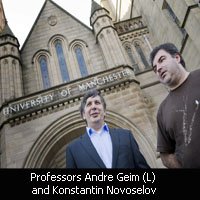Oct 7 2010
The EU is proud to announce that two of its grantees, Professor Konstantin Novoselov and Professor Andre Geim of the University of Manchester in the UK, have been awarded the Nobel Prize in Physics for their groundbreaking work in two-dimensional graphene.
Professor Novoselov and his colleague, Professor Andre Geim, both received the distinguished prize for their work on graphene, a super thin (just one atom thick) wafer of carbon atoms that is set to revolutionise electronics and photonics, such as computers, sensors and solar cells.

Professor Novoselov worked in the Netherlands before making his way to the UK. The Russian-born scientist and his team succeeded in clinching EU grants, including funding from the 'New and emerging science and technology' (NEST) Cross-cutting activity of the EU's Sixth Framework Programme and the European Research Council (ERC), to advance their work.
Graphene is unique in that it is extremely rigid with super mechanical and electronic properties. Using Scotch tape (sticky tape), the material was extracted from a piece of graphite like the kind we find in our pencils. Tests show that the stretchy graphene layers are nearly 100% transparent, making them excellent conductors of heat and electricity.
In a recent Science paper describing the graphene discovery, Professor Novoselov said: '[It] has opened up the increasingly rich possibilities in the development of future electronic devices from this truly versatile material.'
Being awarded the Nobel Prize for Physics is a testament to the hard work carried out by the Professor Novoselov, the youngest Nobel laureate since 1973, and Professor Geim. The prize also puts the spotlight on the steps taken by the EU to promote scientists and their research, as well as cooperation in Europe and beyond.
The discovery of graphene proved a vital component of the NEST-funded SIBMAR ('Obtaining atomically resolved structural information on individual biomolecules using electron holography') project, coordinated by the University of Zurich in Switzerland, which received more than EUR 1.5 million under the FP6's NEST scheme and was bolstered by the participation of Professors Geim and Novoselov whose know-how and innovative insight into graphene helped drive this project.
Bringing together research experts from the Czech Republic, Switzerland and the UK, the SIBMAR project sought to develop a technique for three-dimensional (3D) holographic imaging of biomolecules with atomic-level resolution using low-energy elections for their light.
The SIBMAR partners said a coherent source of low-energy electrons is used to illuminate objects in low-energy electron point-source (LEEPS) microscopy. They developed a prototype LEEPS microscope that could visualise molecular structure down to two angstrom, and tested existing LEEPS microscopes to ensure no defects were reproduced. They also facilitated examination of biomolecules by LEEPS microscopy using different methodologies. This is where graphene came in: the partners tested an option based on atomically thin films constructed from two-dimensional (2D) crystals.
Ever since graphene came under the spotlight, the EU has been a fierce supporter of research in the field, funding more than 40 projects and offering training to researchers. In 2008, a call for research proposals under the Seventh Framework Programme (FP7) (Industrial Technologies (NMP) Theme) was launched.
That Europeans are at the forefront of science cannot be contested; they are fostering frontier research in domains as diverse as engineering and materials science. Helping them in their quest to bring their research to fruition is the EU, which offers critical funding and unwavering support to scientists who want to make a difference. The EU Framework Programmes help to facilitate the very components that go into breakthrough science: cooperation and knowledge exchange, and help the continent?s scientists to achieve amazing results and to stand tall.
Commenting on the Nobel Prize win and what it means for the region, European Commissioner for Research, Innovation and Science Máire Geoghegan-Quinn said: 'Europe can be proud of them and of their work. This is a first for the European Research Council, and I hope more Nobel Prizes will follow as a result of this valuable European investment in the best scientists and in their innovative research in Europe.'
Source: Cordis